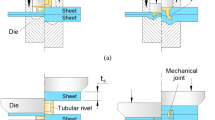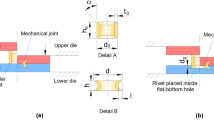Abstract
In this paper, the differences and similarities between two-layer and three-layer self-piercing riveting (SPR) joints were systematically analysed by combining experimental tests and a finite element (FE) model. The influences of top-to-middle sheet thickness ratio (r1) on the joining results of three-layer joints were also numerically investigated. It was found that, compared with the top sheet in two-layer joints, the split top and middle sheets in the corresponding three-layer joints underwent greater plastic deformation. The rivet shank experienced less plastic deformation, and the risk of shear fracture of the rivet shank was effectively reduced. When the r1 increased from 0 to infinity, the interlock (I1) always first increased then decreased and followed by an apparent increase within the studied range. The remaining bottom sheet thickness at the joint centre (tc) and under the rivet tip (ttip) showed opposite changing trends: the tc first increased and then decreased, whilst the ttip first decreased but then increased. The results also revealed that the experimental data of two-layer joints can be used to guide the design of three-layer joints: from the two-layer joints to corresponding three-layer joints, the I1 more likely achieves a greater value when the r1 < 1.0 but a smaller value when the r1 > 1.0, and a larger tc but a smaller ttip are more likely achieved regardless of the r1.































Similar content being viewed by others
References
Cui J, Sun H, Jing L et al (2022) Failure analysis of pulse magnetic induction coil in electromagnetic riveting. Eng Fail Anal 136:106178. https://doi.org/10.1016/j.engfailanal.2022.106178
Zhang WJ, Cross I, Feldman P et al (2017) Electrode life of aluminium resistance spot welding in automotive applications: a survey. Sci Technol Weld Join 22:22–40. https://doi.org/10.1080/13621718.2016.1180844
Han L, Thornton M, Shergold M (2010) A comparison of the mechanical behaviour of self-piercing riveted and resistance spot welded aluminium sheets for the automotive industry. Mater Des 31:1457–1467. https://doi.org/10.1016/j.matdes.2009.08.031
Sun X, Stephens EV, Khaleel MA (2007) Fatigue behaviors of self-piercing rivets joining similar and dissimilar sheet metals. Int J Fatigue 29:370–386. https://doi.org/10.1016/j.ijfatigue.2006.02.054
Haque R, Beynon JH, Durandet Y (2012) Characterisation of force-displacement curve in self-pierce riveting. Sci Technol Weld Join 17:476–488. https://doi.org/10.1179/1362171812Y.0000000036
Fratini L, Ruisi VF (2009) Self-piercing riveting for aluminium alloys-composites hybrid joints. Int J Adv Manuf Technol 43:61–66. https://doi.org/10.1007/s00170-008-1690-3
Han L, Chrysanthou A (2008) Evaluation of quality and behaviour of self-piercing riveted aluminium to high strength low alloy sheets with different surface coatings. Mater Des 29:458–468. https://doi.org/10.1016/J.MATDES.2006.12.020
Xing B, Tang F, Song C, He X (2021) Static and fatigue behavior of self-piercing riveted joints with two overlap areas. J Mater Res Technol 14:1333–1338. https://doi.org/10.1016/j.jmrt.2021.07.064
Abe Y, Kato T, Mori K (2009) Self-piercing riveting of high tensile strength steel and aluminium alloy sheets using conventional rivet and die. J Mater Process Technol 209:3914–3922. https://doi.org/10.1016/j.jmatprotec.2008.09.007
Huang Z-C, Jia Y-L, Jiang Y-Q, Zhang Y-C (2022) Mechanical properties and fatigue failure mechanisms of purely self-piercing riveted (SPR) and hybrid (SPR-bonded) joints under salt spray environment. J Mater Res Technol 20:2501–2517. https://doi.org/10.1016/j.jmrt.2022.08.024
Kang SH, Han DW, Kim HK (2020) Fatigue strength evaluation of self-piercing riveted joints of AZ31 Mg alloy and cold-rolled steel sheets. J Magnes Alloy 8:241–251. https://doi.org/10.1016/j.jma.2019.11.006
Zhao L, He X, Xing B et al (2019) Fracture mechanism of titanium sheet self-piercing riveted joints. Thin-Walled Struct 144:106353. https://doi.org/10.1016/j.tws.2019.106353
Zhang J, Yang S (2015) Self-piercing riveting of aluminum alloy and thermoplastic composites. J Compos Mater 49:1493–1502. https://doi.org/10.1177/0021998314535456
Hassanifard S, Adibeig MR, Mohammadpour M, Varvani-Farahani A (2019) Fatigue life of axially loaded clamped rivet-nut joints: experiments and analyses. Int J Fatigue 129:105254. https://doi.org/10.1016/j.ijfatigue.2019.105254
Lou M, Li Y, Li Y, Chen G (2013) Behavior and quality evaluation of electroplastic self-piercing riveting of aluminum alloy and advanced high strength steel. J Manuf Sci Eng Trans ASME 135. https://doi.org/10.1115/1.4023256
Hur YC, Kim D, Lee KS, Bae MG, Park SE, Kim JH (2020) Finite element analysis of self-piercing riveting of aluminum alloy and carbon fiber reinforced polymer composites. In: IOP Conf Series: Mater Sci Eng 967:012049. https://iopscience.iop.org/article/10.1088/1757-899X/967/1/012049/meta
Ying L, Gao T, Dai M, Hu P, Dai J (2021) Towards joinability of thermal self-piercing riveting for AA7075-T6 aluminum alloy sheets under quasi-static loading conditions. Int J Mech Sci 189:105978. https://doi.org/10.1016/j.ijmecsci.2020.105978
Ma Y, Lou M, Li Y, Lin Z (2018) Effect of rivet and die on self-piercing rivetability of AA6061-T6 and mild steel CR4 of different gauges. J Mater Process Technol 251:282–294. https://doi.org/10.1016/J.JMATPROTEC.2017.08.020
Mucha J (2011) A study of quality parameters and behaviour of self-piercing riveted aluminium sheets with different joining conditions. Stroj Vestnik/Journal Mech Eng 57:323–333. https://doi.org/10.5545/sv-jme.2009.043
Hoang N-H, Porcaro R, Langseth M, Hanssen A-G (2010) Self-piercing riveting connections using aluminium rivets. Int J Solids Struct 47:427–439. https://doi.org/10.1016/j.ijsolstr.2009.10.009
Karim MA, Jeong TE, Noh W et al (2020) Joint quality of self-piercing riveting (SPR) and mechanical behavior under the frictional effect of various rivet coatings. J Manuf Process 58:466–477. https://doi.org/10.1016/j.jmapro.2020.08.038
Kam DH, Jeong TE, Kim MG, Shin J (2019) Self-piercing riveted joint of vibration-damping steel and aluminum alloy. Appl Sci 9:4575. https://doi.org/10.3390/app9214575
Landgrebe D, Jäckel M, Niegsch R (2015) Influence of process induced damages on joint strength when self-pierce riveting carbon fiber reinforced plastics with aluminum. Key Eng Mater 651:1493–1498. https://doi.org/10.4028/www.scientific.net/KEM.651-653.1493
Drossel WG, Jäckel M (2014) New die concept for self-pierce riveting materials with limited ductility. Key Eng Mater 611:1452–1459. https://doi.org/10.4028/www.scientific.net/KEM.611-612.1452
Abe Y, Kato T, Mori K (2008) Self-pierce riveting of three high strength steel and aluminium alloy sheets. Int J Mater Form 1:1271–1274. https://doi.org/10.1007/s12289-008-0134-9
Kato T, Abe Y, Mori K (2007) Finite element simulation of self-piercing riveting of three aluminium alloy sheets. Key Eng Mater 340:1461–1466. https://doi.org/10.4028/www.scientific.net/kem.340-341.1461
Han L, Chrysanthou A, Young KW (2007) Mechanical behaviour of self-piercing riveted multi-layer joints under different specimen configurations. Mater Des 28:2024–2033. https://doi.org/10.1016/j.matdes.2006.06.015
Ding W, He X, Liu J, Liu J, Wei W (2018) Research on the performance of self-pierce riveting based on CFRP-AA5052 aluminum alloy three-layer sheets. Sci Technol Eng 18:25. http://www.stae.com.cn/jsygc/article/abstract/1802793
Çavuşoğlu O, Bakırcı A, Dinkçi H, Yılmazoğlu AG (2022) Triple joining of different sheets with self-pierce riveting method. Sci Technol Weld Join 27:579–585. https://doi.org/10.1080/13621718.2022.2091341
Achira S, Abe Y, Mori KI (2022) Self-pierce riveting of three thin sheets of aluminum alloy A5052 and 980 MPa steel. Materials (Basel) 15. https://doi.org/10.3390/ma15031010
Liu Y, Li H, Zhao H, Liu X (2019) Effects of the die parameters on the self-piercing riveting process. Int J Adv Manuf Technol 105:3353–3368. https://doi.org/10.1007/s00170-019-04567-4
Liu Y, Han L, Zhao H, Liu X (2021) Numerical modelling and experimental investigation of the Riv-Bonding process. J Mater Process Technol 288:116914. https://doi.org/10.1016/j.jmatprotec.2020.116914
Carandente M, Dashwood RJ, Masters IG, Han L (2016) Improvements in numerical simulation of the SPR process using a thermo-mechanical finite element analysis. J Mater Process Technol 236:148–161. https://doi.org/10.1016/j.jmatprotec.2016.05.001
Hönsch F, Domitner J, Sommitsch C, Götzinger B (2020) Modeling the failure behavior of self-piercing riveting joints of 6xxx aluminum alloy. J Mater Eng Perform 29:4888–4897. https://doi.org/10.1007/s11665-020-04894-8
Zhao H, Han L, Liu Y, Liu X (2022) Analysis of joint formation mechanisms for self-piercing riveting (SPR) process with varying joining parameters. J Manuf Process 73:668–685. https://doi.org/10.1016/j.jmapro.2021.11.038
Li D (2017) Influence of aluminium sheet surface modification on the self-piercing riveting process and the joint static lap shear strength. Int J Adv Manuf Technol 93:2685–2695. https://doi.org/10.1007/s00170-017-0710-6
Asaro R, Lubarda V (2010) Mechanics of solids and materials. Mechanics of Solids and Materials. Cambridge University Press, Cambridge, pp 280–292
Liu Y, Han L, Zhao H, Liu X (2021) Experimental investigation of the adhesive layer’s impact on the Riv-Bonding process and joint quality. Thin-Walled Struct 167:108255. https://doi.org/10.1016/j.tws.2021.108255
Hoang NH, Hopperstad OS, Langseth M, Westermann I (2013) Failure of aluminium self-piercing rivets: an experimental and numerical study. Mater Des 49:323–335. https://doi.org/10.1016/j.matdes.2013.01.034
Zhang X, He X, Xing B, Wei W, Lu J (2020) Pre-holed self-piercing riveting of carbon fibre reinforced polymer laminates and commercially pure titanium sheets. J Mater Process Technol 279:116550. https://doi.org/10.1016/J.JMATPROTEC.2019.116550
Acknowledgements
The authors would like to thank Dr. Matthias Wissling, Paul Bartig and their team members from Tucker GmbH for their support during the laboratory tests.
Funding
This research is funded by Jaguar Land Rover.
Author information
Authors and Affiliations
Contributions
All authors contributed to the study conception and design. Material preparation, data collection and analysis were performed by Huan Zhao and Yunpeng Liu. The first draft of the manuscript was written by Huan Zhao and all authors commented on previous versions of the manuscript. All authors read and approved the final manuscript.
Corresponding author
Ethics declarations
Ethics approval
Not applicable.
Consent to participate
All the authors participated in this research.
Consent for publication
All the authors approved the final manuscript for publication.
Conflict of interest
The authors declare no competing interests.
Additional information
Publisher's note
Springer Nature remains neutral with regard to jurisdictional claims in published maps and institutional affiliations.
Rights and permissions
Springer Nature or its licensor (e.g. a society or other partner) holds exclusive rights to this article under a publishing agreement with the author(s) or other rightsholder(s); author self-archiving of the accepted manuscript version of this article is solely governed by the terms of such publishing agreement and applicable law.
About this article
Cite this article
Zhao, H., Han, L., Liu, X. et al. Comparisons of formation process and quality between two-layer and three-layer self-piercing riveted joints. Int J Adv Manuf Technol 127, 4745–4767 (2023). https://doi.org/10.1007/s00170-023-11825-z
Received:
Accepted:
Published:
Issue Date:
DOI: https://doi.org/10.1007/s00170-023-11825-z




